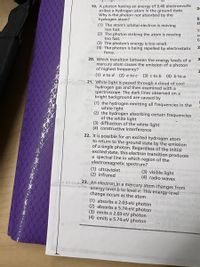Question
This is a multiple choice question so you can just give me the letter of the answer. This is one question with 5 parts so it is not against guidelines to answer all 5 parts.

Transcribed Image Text:19. A photon having an energy of 9.40 electronvolts
strikes a hydrogen atom in the ground state.
Why is the photon not absorbed by the
hydrogen atom?
(1) The atom's orbital electron is moving
too fast.
(2) The photon striking the atom is moving
too fast.
(3) The photon's energy is too small.
(4) The photon is being repelled by electrostatic
force.
20
B.
th
TI
20. Which transition between the energy levels of a
mercury atom causes the emission of a photon
of highest frequency?
(1) e to d (2) e to c (3) c to b (4) b to a
* 21. White light is passed through a cloud of cool
hydrogen gas and then examined with a
spectroscope. The dark lines observed on a
bright background are caused by
(1) the hydrogen emitting all frequencies in the
white light
(2) the hydrogen absorbing certain frequencies
of the white light
(3) diffraction of the white light
(4) constructive interference
22. It is possible for an excited hydrogen atom
to return to the ground state by the emission
of a single photon. Regardless of the initial
excited state, this electron transition produces
a spectral line in which region of the
electromagnetic spectrum?
(1) ultraviolet
(2) infrared
(3) visible light
(4) radio waves
sir 23. An electron in a mercury atom changes from
energy level b to level e. This energy-level
change occurs as the atom
(1) absorbs a 2.03-eV photon
(2) absorbs a 5.74-eV photon
(3) emits a 2.03-eV photon
(4) emits a 5.74-eV photon
Expert Solution
This question has been solved!
Explore an expertly crafted, step-by-step solution for a thorough understanding of key concepts.
This is a popular solution
Trending nowThis is a popular solution!
Step by stepSolved in 2 steps

Knowledge Booster
Similar questions
- Given a set of length measurements: 62.1, 62.5, 61.7, 62.6, 62.7, 61.9 cm. Find the standard error for length measurement.arrow_forwardS Can 6 PAR к Торс K Unit K In x K Moti = Cop K Unit S Spee S Topo S Math Micr eb.kamihq.com/web/viewer.html?source-filepicker&document_identifier=137VZR5BZOVSAIMOA55WU555_CvJ9NacO + 100 P e Interpreting Graphs Answer the questions following the graphs on each side Dietance va. Time 2 7 10 11 12 13 14 Time in soconds 1. From 1 second to 2 seconds, how fast is the object traveling. (Take the difference in distance and divide it by the time in between the 2 distances) 2. Is the object going as fast between 9 and 12 seconds as it is between 1 and 4 seconds? How can you tell? 3. What is the motion of the object between 4 and 6 seconds? acerarrow_forwardThe followings are the measurements from one group of students: M1=127.01 g, M2=49.40 g, Xi=33.90 cm, Xf=87.90 cm, Δt = 1.38 sec, what should be their μk value? Enter the result with correct significant figures.arrow_forward
- It's showing that b is not correct. Thank you for your help with this practice problem.arrow_forward(2) 5. Find the least expensive route from a to g in the graph. 1 a 5 42 40 20 f d 45 b 35 75 8 (3) 6. Find the chromatic number and express a coloring of the following graph. b 85 e 55 6 (3) 7. Is this a planar graph? If so, draw a planar representation of the graph. If not, explain why it is not planar. 60 earrow_forwardI need help with a University Physics 1 (significant figures) - The problem is described in the image below:arrow_forward
- An engineer uses a stopwatch to measure the duration of an event. The digital stopwatch reading shows 0.77 s. (a) What uncertainty is implied by the reading itself without any other knowledge? (b) Suppose the stopwatch manufacturer specifications state an error of up to 1% of the reading. What value of uncertainty might you state with the reading? (c) Suppose the engineer adds an uncertainty of 0.05 s due to reaction time. What uncertainty might you state with the reading?arrow_forwardA relationship is found between the number density of cars on a freeway during rush hour, N, and distance. The relationship can be written as k a'N No dr? From this you can conclude that O w = V No O v = No No O v =arrow_forwardNeeds Complete typed solution with 100 % accuracy.arrow_forward
arrow_back_ios
arrow_forward_ios